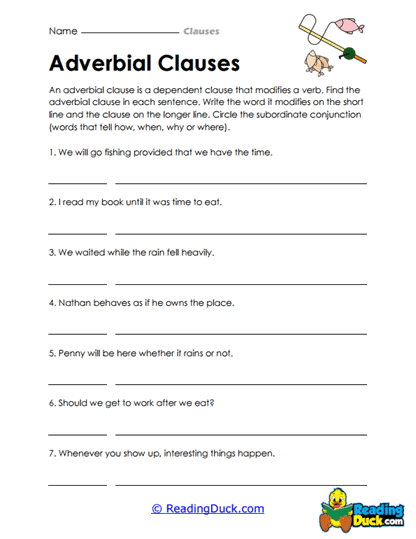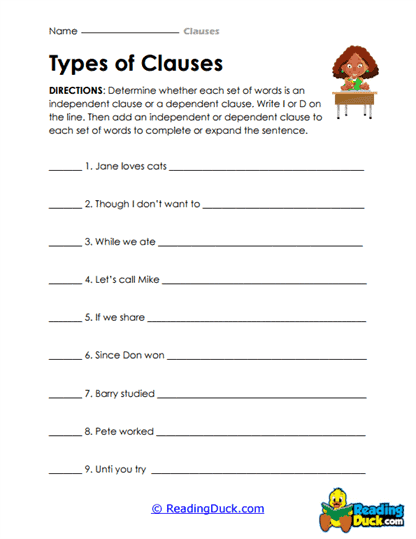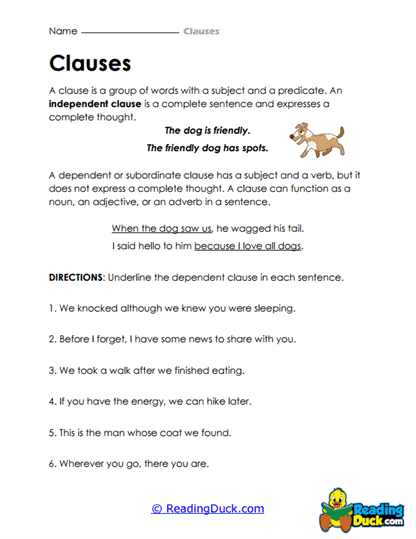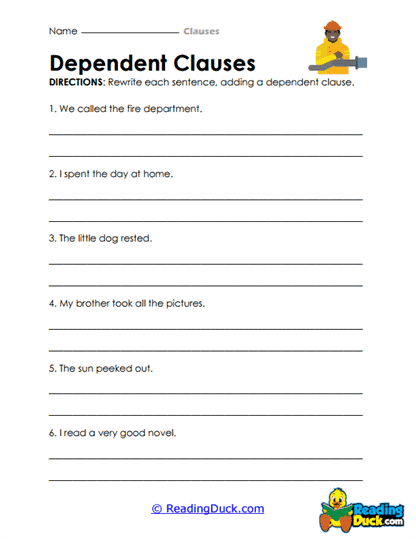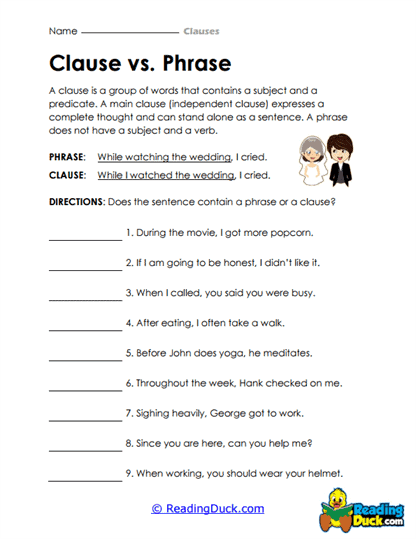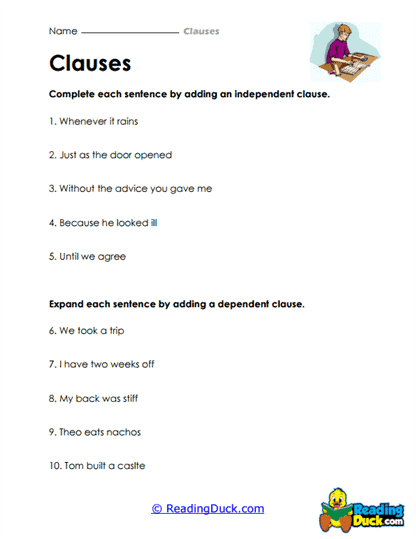Clauses Worksheets
About Our Clause Worksheets
Our Clauses Worksheets collection is designed to help students master the fundamental skill of identifying and using clauses correctly in writing. Clauses are essential components of sentence structure, playing a crucial role in crafting clear, engaging, and grammatically correct sentences. This collection of worksheets covers a wide range of topics related to clauses, including independent and dependent clauses, subordinating conjunctions, and compound-complex sentence construction.
These worksheets are available in PDF format, allowing educators and parents to easily view, download, and print them for classroom or home use. Each worksheet comes with a downloadable answer key, making it simple to assess student progress. Whether used as part of a structured language arts curriculum or as supplemental practice, these worksheets provide students with practical exercises to improve their understanding of clauses and sentence construction.
What Are Clauses?
In grammar, a clause is a group of words that contains both a subject and a verb. Clauses can either be independent or dependent, and understanding the difference is crucial for mastering sentence structure:
- Independent Clauses: These are complete thoughts that can stand alone as a sentence. For example, "She loves reading" is an independent clause because it expresses a complete idea.
- Dependent Clauses: These clauses contain a subject and verb but cannot stand alone as a sentence because they do not express a complete thought. For instance, "Because she loves reading" is a dependent clause and requires an independent clause to form a complete sentence (e.g., "Because she loves reading, she goes to the library every weekend").
Why Clauses Matter: Clauses are the building blocks of sentences, and mastering them allows students to write more complex, varied, and nuanced sentences. Understanding clauses also enables students to:
- Create complex sentences: By combining independent and dependent clauses, students can avoid simple, repetitive sentences and develop a more sophisticated writing style. For example, instead of writing, "I went to the park. I saw my friend," students can combine the two ideas: "I went to the park, and I saw my friend."
- Enhance clarity and precision: Clauses help students express ideas more clearly and concisely. For instance, "Although it was raining, we went hiking" gives a reason for the action in one smooth sentence.
Real-world Applications: Understanding how to effectively use clauses improves both spoken and written communication. In everyday scenarios such as writing essays, creating reports, or even participating in conversations, having a solid grasp of clauses enables students to structure their ideas logically and cohesively. Beyond the classroom, professionals use complex sentences to explain, persuade, and engage in a variety of fields, from business writing to creative storytelling.
Building Skills with a Structured Approach
Our Clauses Worksheets are carefully designed to follow a scaffolded learning approach, helping students build their understanding gradually. The collection progresses from basic to more advanced tasks, ensuring that students develop a comprehensive mastery of clauses over time.
Progression in the Worksheets:
- Introductory Tasks: Students begin by identifying independent and dependent clauses. These foundational worksheets focus on helping learners distinguish between complete and incomplete thoughts, such as identifying the clause in sentences like, "When the bell rang, the students left the classroom."
- Combining Clauses: As students gain confidence, they move on to combining clauses to form compound and complex sentences. For example, they might be asked to merge independent clauses with coordinating conjunctions like "and," "but," or "so." A task might include: "Combine these two sentences: ‘She studied hard. She passed the exam.’ into ‘She studied hard, so she passed the exam.’"
- Understanding Subordination: More advanced worksheets introduce subordinating conjunctions (e.g., "although," "because," "if") to create dependent clauses. This step helps students understand how to add depth and complexity to their writing. For example, "I will go to the store" becomes more informative when turned into, "If I have time, I will go to the store."
- Advanced Sentence Structures: The final set of worksheets focuses on creating compound-complex sentences, which require students to combine multiple independent and dependent clauses. These exercises challenge students to use varied sentence structures in their writing, such as: "Although she was tired, she finished her homework, and then she went to bed."
By following this structured approach, students gain the skills needed to write with greater complexity and sophistication.
Supporting Educators and Parents in Tracking Progress
Each worksheet in our collection is accompanied by a downloadable answer key, making it simple for educators and parents to assess student progress. These keys provide the correct responses to each task and offer insights into how students should approach more complex exercises.
Tips for Evaluating Student Performance:
- Accuracy in Identifying Clauses: Start by checking if students can correctly identify independent and dependent clauses. A good indicator of understanding is whether students can explain why a certain clause is independent (expresses a complete thought) or dependent (requires more information to be complete).
- Combining Clauses Effectively: As students progress, look for their ability to combine clauses seamlessly. Evaluate whether they can use coordinating and subordinating conjunctions correctly to form logical, grammatically sound sentences.
- Variety in Sentence Structure: More advanced worksheets require students to create compound-complex sentences. Evaluate whether students are using different sentence structures in their writing, avoiding overly simple or repetitive sentence patterns.
Teachers and parents can also encourage students to review their answers and reflect on their work, reinforcing critical thinking and self-assessment.
Accessible Learning for ESL and Struggling Writers
Our Clauses Worksheets are designed to be adaptable for a wide range of learners, including ESL students and those who may need additional support with writing. The worksheets are structured in a way that breaks down complex grammar concepts into manageable chunks, making them accessible to all learners.
Adaptations for Diverse Learning Needs:
- Simple Sentence Exercises for ESL Learners: Start ESL students with basic exercises that focus on identifying independent clauses in simple sentences, such as "The dog barked." This gives them a foundational understanding before moving on to more complex tasks.
- Guided Practice: Offer sentence starters or example clauses to help students who need additional support. For example, provide a dependent clause such as "Because it was raining," and ask students to complete the sentence by adding an independent clause.
- Visual Aids: Encourage students to use diagrams or sentence trees to visualize how clauses work within a sentence. This technique can be particularly helpful for visual learners who need to see the structure of the sentence to grasp the concept.
By providing extra guidance and resources, educators can ensure that all students, regardless of language proficiency or writing ability, can succeed with these worksheets.
Adapting the Worksheets for Different Learning Environments
Our Clauses Worksheets are versatile and can be adapted to meet the needs of different skill levels and learning settings. Whether students are just beginning to learn about clauses or are ready for more advanced tasks, these worksheets provide valuable practice for learners at every stage.
For Beginner Students:
- Use the worksheets to introduce basic concepts like independent and dependent clauses. Focus on simple sentences and help students build confidence with identifying and using clauses correctly.
For Advanced Learners:
- Challenge advanced students with worksheets that focus on compound-complex sentences and more intricate sentence structures. Encourage them to apply these skills to their creative writing or essay assignments.
Flexible Integration in Classrooms:
- Main Instructional Tool: These worksheets can serve as the foundation for a grammar lesson on clauses, helping students master essential writing skills through structured practice.
- Supplemental Resource: Teachers can also use the worksheets as supplemental material to reinforce learning, assign homework, or offer extra practice for students who need additional support.
Enhancing Writing Skills Through Clauses
Our Clauses Worksheets collection equips students with the tools they need to write more clearly, concisely, and effectively. By understanding how to identify and use independent and dependent clauses, students can create more varied and engaging sentences in both academic and creative writing. With their scaffolded structure, easy-to-use formats, and downloadable answer keys, these worksheets offer invaluable support for teachers, parents, and students alike.
From foundational exercises to advanced sentence-building tasks, our worksheets help learners improve their writing skills in a practical, hands-on way. Whether used in the classroom or at home, they provide an engaging, accessible approach to mastering clauses and improving overall sentence structure.

